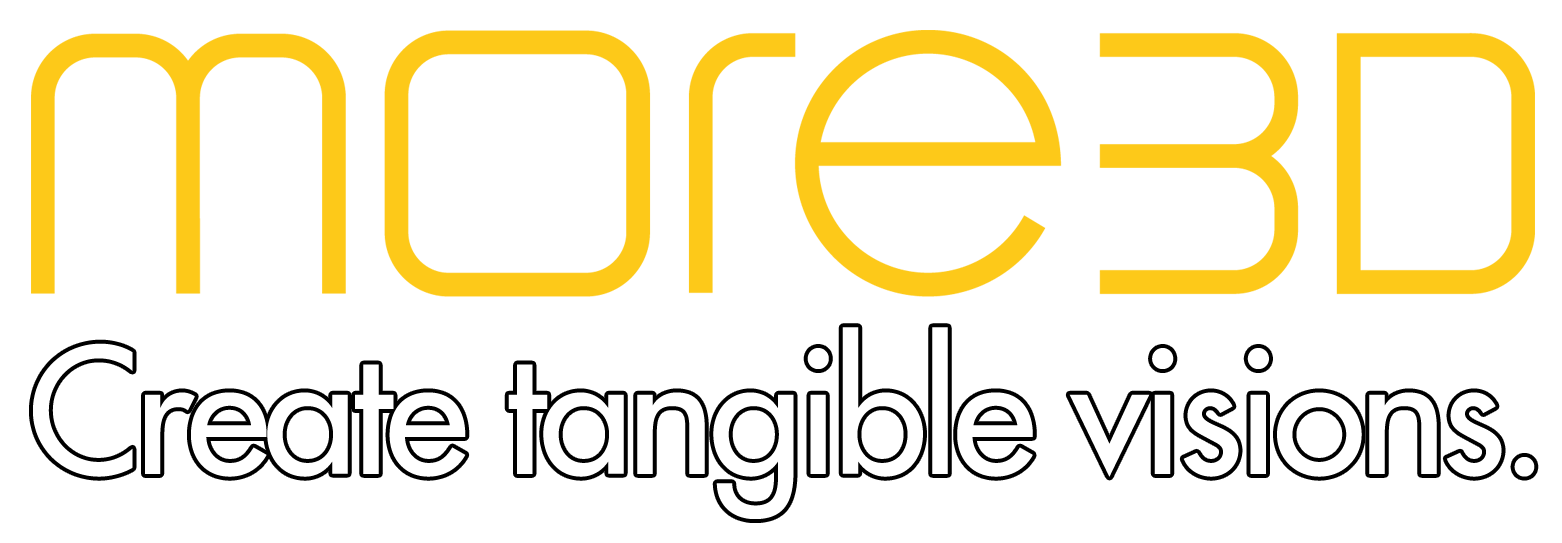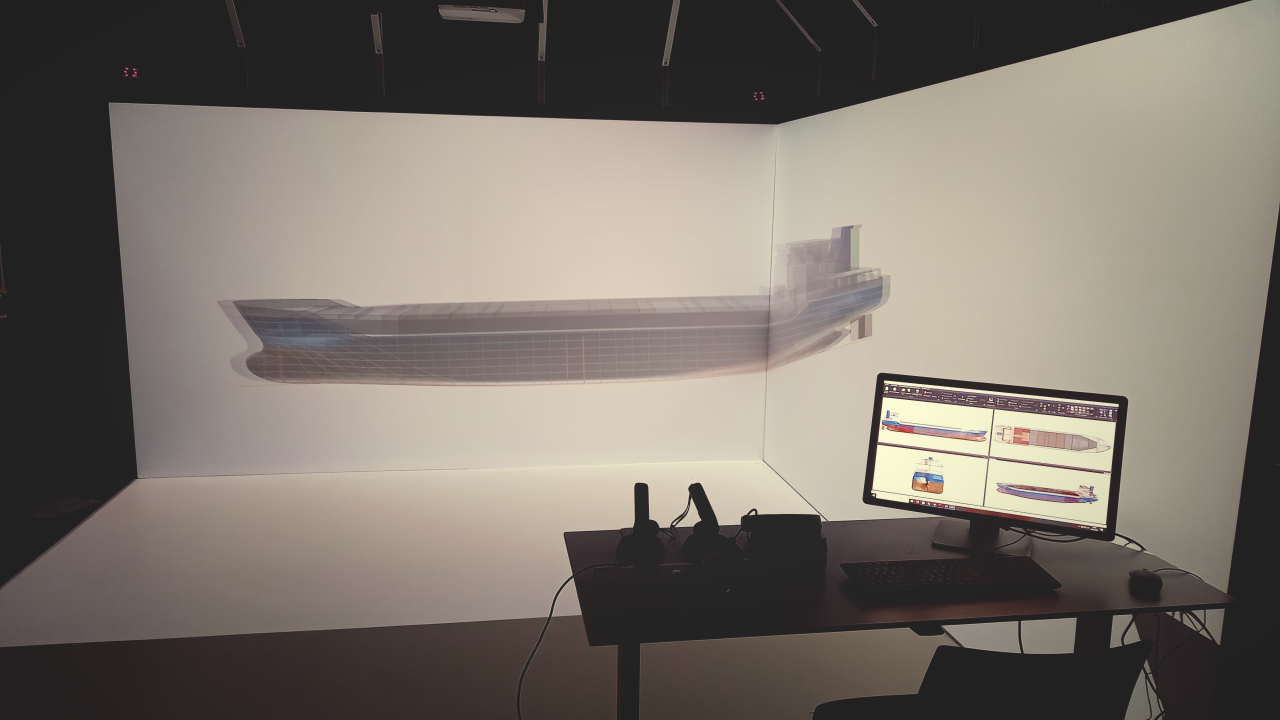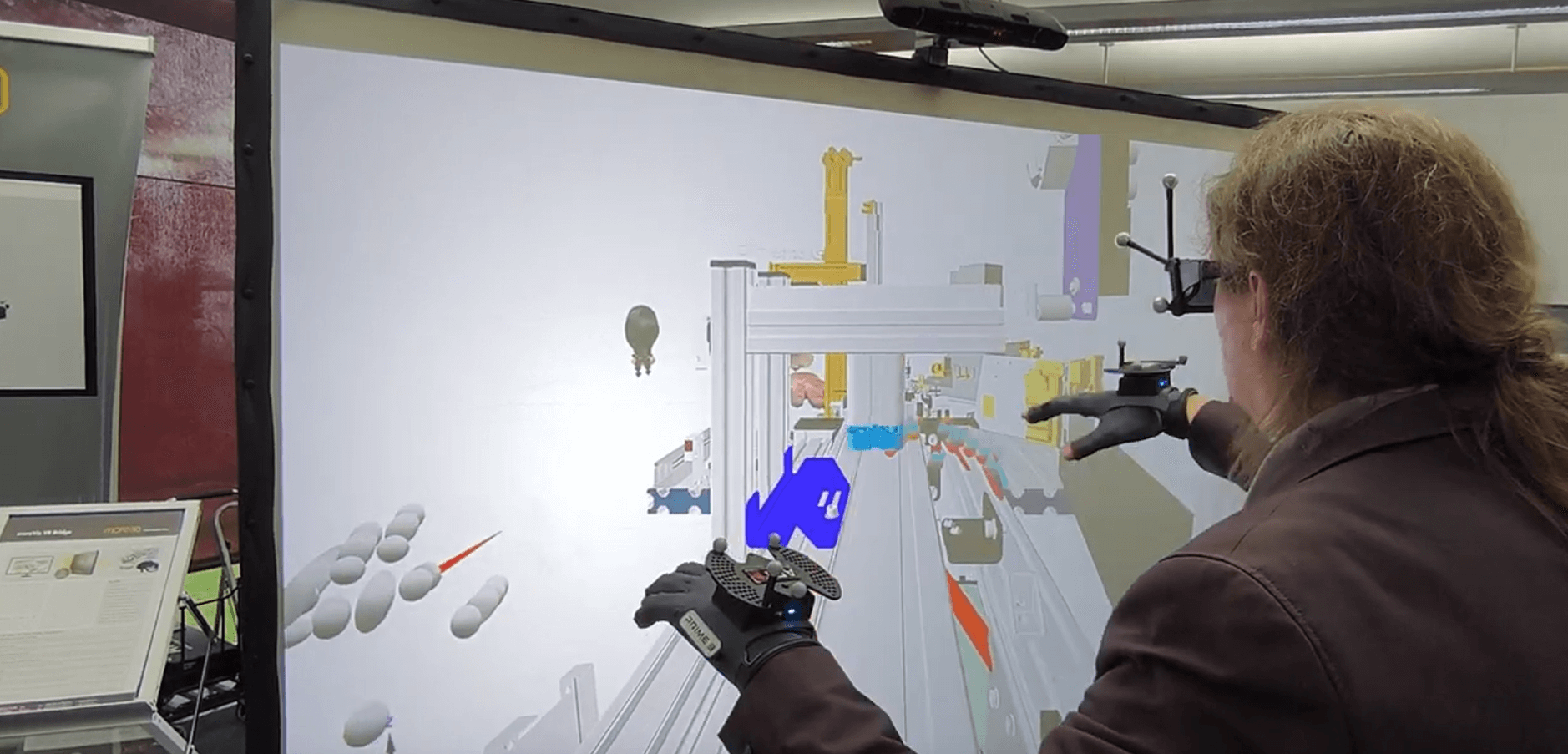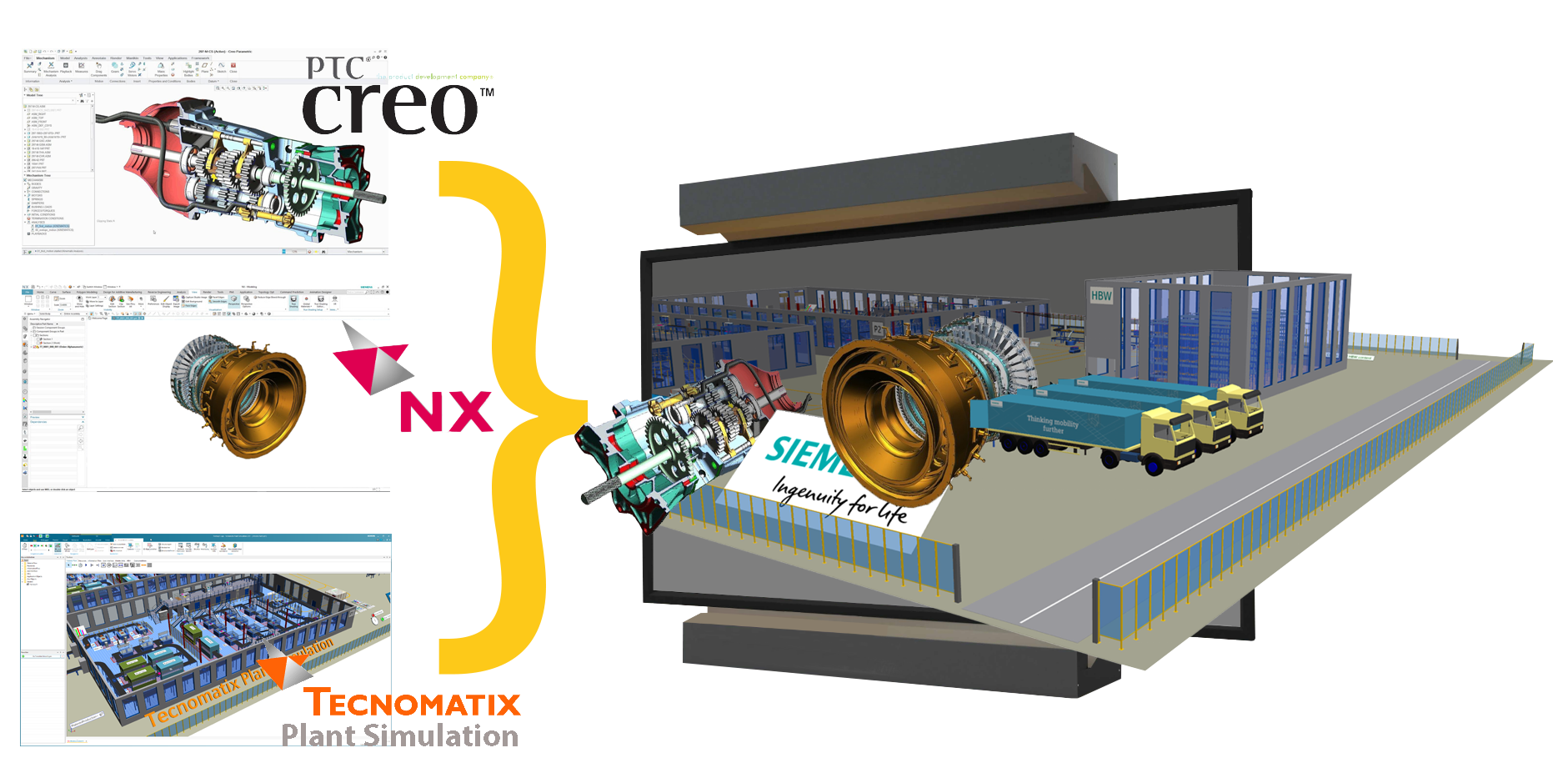Immersive Teaching and Research with Virtual Reality
Imagine stepping inside a life-sized ship model—walking its decks, inspecting its structure, and even simulating emergency evacuations—all without leaving the room.
For nearly a decade, this has been a reality at the University of Applied Sciences (UAS) Emden / Leer, in the Faculty of Maritime Sciences, where a VR-powered lab featuring a three-sided CAVE system (a room-sized VR system where 3D content is projected onto surrounding walls) has enhanced maritime education. In collaboration with more3D, the university offers students immersive learning experiences, enabling them to interact with 3D models, explore ship designs at full scale, and train for real-world applications in the maritime industry.
A Strong Collaboration: UAS Emden / Leer & more3D
UAS Emden / Leer – Innovating Maritime Education
The Hochschule Emden/Leer specializes in maritime research and the training of future captains, officers, and maritime management engineers. The faculty emphasizes practical, technology-driven education to prepare students for careers in the maritime sector, including shipyards, shipping companies, and the offshore industry.
more3D – VR Technology Experts
more3D is a Germany-based pioneer in 3D stereo and virtual reality solutions, offering turnkey immersive experiences. Their moreViz software enables real-time interaction with CAD models, seamlessly integrating with VR powerwalls, CAVEs, and head-mounted displays (HMDs).
The Vision: Transforming Learning with a Cutting-Edge VR Lab
For decades, ship design education relied on 2D screens and blueprints. UAS Emden / Leer sought a way to enhance their education program, bridging the gap between theory and hands-on application while preparing students for future technological advancements in the maritime sector. The use of virtual reality (VR) makes it significantly easier to grasp spatial relationships, structural details, and operational challenges.
By integrating a VR lab, the university created an environment where:
- Students learn to interact with VR models, experience the potential of the technology, and prepare for future maritime careers.
- Researchers gain deeper insights and collaborate more effectively in 3D/ VR-models. One example is the EU-funded GreenSailer Project, which aims to develop a prototype of an innovative cargo glider for coastal shipping and island supply — a vessel designed to fulfill the vision of a ‘zero-emission ship’.
- Technology becomes accessible to industry, through projects such as “Mittelstand 4.0 (Competence Center Lingen),” where small and mid-sized businesses can test and evaluate real-world applications of VR.

Implementation: Unlocking New Potential for Education and Research
To realize its vision, UAS Emden / Leer installed a three-sided CAVE system—an immersive 3D environment where high-resolution projections on three walls create a lifelike, interactive simulation. more3D provided the necessary software. moreViz was chosen for its seamless integration with professional tools, ensuring real-time updates and modifications.
Key Facts:
✔ Fast Installation: The system was set up in less than a day.
✔ Custom Integration: At the university’s request, more3D developed a special interface for DelftShip, a ship design tool. @delftshi
✔ Investment: The setup, which included front, left, and floor projection along with the necessary hardware and software, cost under EUR 150K.
✔ Continuous Upgrades: Over nearly 10 years, more3D has provided ongoing support, software enhancements, and hardware consultation, including remote maintenance.
✔ Interactivity: The system uses a tracking system and moreViz software, functioning as an interactive tool—unlike passive 3D cinemas—allowing users to manipulate models, select components, and make live modifications.
✔ User-Friendly Learning Curve: Since moreViz was developed collaboratively with global customers, most users become proficient within 30–60 minutes.
✔ Software Integration: UAS Emden / Leer primarily uses the VR lab for Siemens Industry & Tecnomatix Solutions Plant Simulation, DelftShip, SketchUp, and other Siemens CAD software—but it can support other tools as well.
✔ Remote Collaboration: moreViz enables teams in different locations to work together in real time, improving communication and efficiency.

Impact: A New Standard for Education, Training and Research
UAS Emden / Leer’s VR lab has significantly enhanced education and industry collaboration:
✔ Hands-on Learning & Student Engagement– Students explore virtual ships, analyse full-scale models, and design their own. For example, a full-scale Titanic model has been virtualized for exploration.
✔ Higher Retention & Enthusiasm– VR emotionally engages students, making learning more impactful and improving the learning curve.
✔ Industry Collaboration & Research – Projects such as Mittelstand 4.0use the VR lab for business purposes. VR enables more effective design reviews and validation of ship equipment, logistics, and safety procedures like evacuation plans. It also supports planning for preventive maintenance.
✔ Collaborative Research– Multiple users can enter the CAVE, interact with the same 3D model, and exchange ideas—opening new perspectives in design and analysis.
✔ Process Optimization – Thanks to the partnership between Siemens and more3D, PlantSimulation was easily integrated, allowing users to review and refine logistics processes, such as supply chain planning for offshore wind parks. Edits and simulations can now be performed directly within the VR environment. Being immersed in the process allows for improvements in efficiency, such as optimizing worker routes.
Challenges & Lessons Learned
Like any long-term tech initiative, UAS Emden / Leer encountered challenges:
- Leadership Transition – After the passing of the lead professor, new research projects temporarily slowed, though the CAVE continued to be actively used for education. Strong leadership and internal promotion are crucial for maximizing VR’s potential, as is allocating sufficient resources.
- Software Adaptation – Early integration of DelftShip caused model distortions. However, collaborative feedback and iterative improvements resulted in a fully functional version.
What Made the Project Successful?
✔ Strong Partnership– Over the years, more3D has offered fast, flexible, and creative support, helping the university address technical challenges while staying within budget.
✔ User-Centric Development– UAS Emden / Leer’s feedback directly influenced software development, resulting in practical and user-friendly features.
✔ Future-Proof System– Regular updates keep the VR lab on the cutting edge.
✔ Encouraging Experimentation – During the Mittelstand 4.0project, hands-on workshops encouraged users to brainstorm VR applications, leading to real-world adoption.
✔ Scalability Considerations – While CAVEs are often better suited for large institutions and enterprises, HMDs offer a cost-effective alternative for smaller businesses. Regardless of setup, it’s essential to have clear objectives and defined use cases before choosing a hardware architecture.
Find out more:
A Look Into the Future
Lars Ostrowitzki, Research Assistant at UAS Emden / Leer, reflects on VR’s evolving role:
“With AI currently in the spotlight, the hype around VR has cooled slightly, which also shows that it has become part of regular business. But immersive technology still holds massive potential. It offers a unique perspective, allowing users to experience designs firsthand rather than analysing them on screens. In the future, VR will become an intuitive way to communicate with machines—beyond mouse and keyboard interactions. Among many other things it can even open new marketing opportunities—imagine a client walking through their vessel in VR before signing a contract.”
Prof. Dr. Sebastian Werning, Professor for Digital Transformation and Logistics at UAS Emden / Leer, emphasizes the clear need for immersive technologies in response to today’s industrial challenges:
“In an increasingly complex and regulated industrial landscape, companies must respond faster and more cost-effectively to global market demands. VR offers a standardized and intuitive way to visualize 3D content — enabling everything from construction planning and logistics to virtual collaboration across continents.”
With its immersive VR lab, UAS Emden / Leer is setting new standards for maritime education. The ability to visualize, interact, and collaborate in VR is not only enhancing student learning—it’s unlocking new possibilities for the maritime industry.
Want to Explore How VR Can Transform Your Training and Design Processes?
Contact more3D today and discover how immersive visualization can revolutionize education, research, and industry practices.
Want to get an Insight into maritime Education with VR?
Contact UAS Emden/Leer and explore construction and collaboration use cases of the maritime industry.




